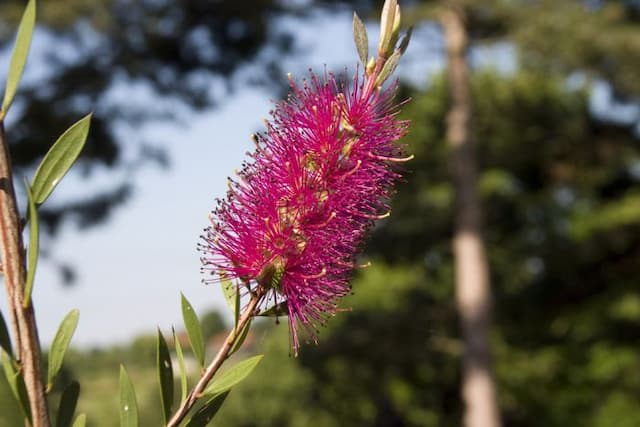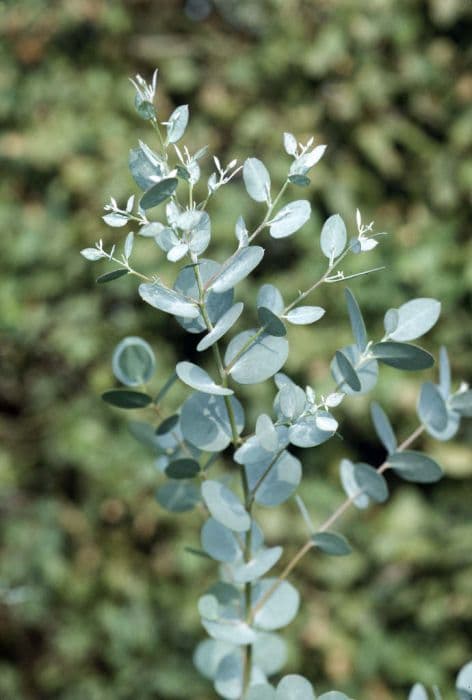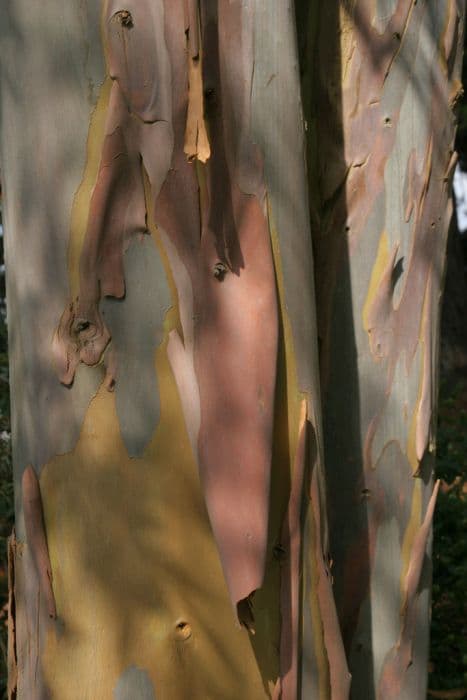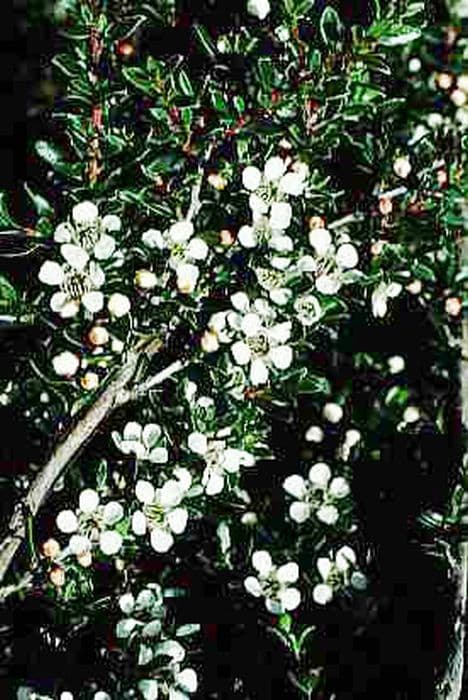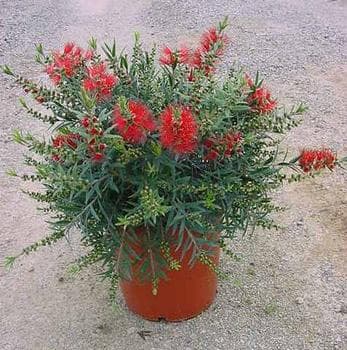Narrow-leaved Black Peppermint Eucalyptus nicholii

ABOUT
The Eucalyptus nicholii, commonly known as the Narrow-leaved Black Peppermint or Willow Peppermint, is a visually striking plant characterized by its weeping habit and dense foliage. The leaves of this plant are particularly noteworthy; they are narrow, willow-like, and hang elegantly from the branches. Young leaves exhibit a bright green color, which matures to a deeper green hue, sometimes with a bluish or grayish tint, adding to the plant's visual appeal. The leaves are aromatic, releasing a refreshing peppermint-like scent when crushed, which is a distinctive feature of the Narrow-leaved Black Peppermint. It blooms with clusters of small white flowers that can add a decorative touch to the plant's appearance. The flowers are often rich in nectar, attracting a variety of pollinators to the garden. The bark of the Narrow-leaved Black Peppermint is another defining characteristic, displaying a deeply furrowed texture that can exfoliate in small flakes, revealing patches of the smooth, underbark in a contrasting color. This rich textural quality contributes to the overall ornamental value of the plant, making it an interesting and attractive choice for both residential and public landscapes.
About this plant
 Names
NamesSynonyms
Willow Peppermint, Narrow-leaved Black Peppermint, Narrow-leaved Peppermint.
Common names
Eucalyptus nicholii.
 Toxicity
ToxicityTo humans
The Eucalyptus, specifically Eucalyptus nicholii, is toxic to humans if ingested. The oil contained within the leaves of the Eucalyptus plant can cause severe gastrointestinal upset, central nervous system depression, and if consumed in greater quantities, it can lead to more serious symptoms such as seizures. Ingesting the leaves or oil of the Eucalyptus can also result in nausea, vomiting, and diarrhea. It is important to handle Eucalyptus with care and ensure it is not ingested, especially by children, as they are more susceptible to the toxic effects.
To pets
Eucalyptus is toxic to pets, including dogs and cats, and can lead to Eucalyptus poisoning if they ingest any part of the plant. The symptoms of poisoning in pets can include salivation, vomiting, diarrhea, depression, weakness, and on rarer occasions, seizures. Cats may be more sensitive to Eucalyptus oil and the consequences of ingesting the plant can be potentially more severe. It is crucial to prevent pets from having access to any Eucalyptus plants or products to ensure their safety.
 Characteristics
CharacteristicsLife cycle
Perennials
Foliage type
Evergreen
Color of leaves
Green
Flower color
White
Height
50 feet (15 meters)
Spread
30 feet (9 meters)
Plant type
Tree
Hardiness zones
9
Native area
Australia
Benefits
 General Benefits
General Benefits- Aesthetic appeal: Eucalyptus nicholii, commonly known as narrow-leaved black peppermint, Willow Peppermint or Nichol's Willow-leaved eucalyptus, has a weeping habit and slender, willow-like leaves that provide a distinctive, graceful appearance.
- Drought tolerance: Once established, this species is particularly resistant to drought, making it a good choice for arid climates and water-wise gardens.
- Wind resistance: Its strong wood and flexible branches enable it to withstand high winds, which can be beneficial in exposed or coastal locations.
- Shade provider: The tree offers a cool, shaded area beneath its canopy, making it a practical addition to parks, gardens, and landscape designs.
- Erosion control: The deep and extensive root system of the eucalyptus can help stabilize soil and prevent erosion.
- Habitat for wildlife: Eucalyptus nicholii provides a habitat and food source for various bird species, insects, and wildlife, enhancing biodiversity.
- Fast growth: This eucalyptus variety is known for its quick growth rate, allowing for rapid establishment and the swift creation of shade or a screen.
- Climate adaptation: It is able to adapt to a variety of climates, making it suitable for planting in diverse geographical locations.
 Medical Properties
Medical Properties- Antimicrobial: Eucalyptus nicholii contains cineole, which has been known to exhibit antimicrobial properties against a range of bacteria, fungi, and viruses.
- Anti-inflammatory: Components like eucalyptol found in the essential oil of the plant may help reduce inflammation.
- Decongestant: The vapors from eucalyptus oil, which can be derived from this species, are often used to help alleviate congestion and respiratory tract infections.
- Antioxidant: The plant may contain flavonoids and tannins that could have antioxidant effects, which can be beneficial in protecting the body against oxidative stress.
- Analgesic: Eucalyptus oil, when applied topically, may help in relieving minor aches and pains due to its possible analgesic properties.
 Air-purifying Qualities
Air-purifying QualitiesThis plant is not specifically known for air purifying qualities.
 Other Uses
Other Uses- Eucalyptus nicholii leaves can be used in the creation of natural dyes for fabrics, offering a range of colors from greens to yellows depending on the mordant used.
- The wood of Eucalyptus nicholii, being hard and dense, is suitable for woodworking projects, particularly for crafting furniture or turned objects.
- Due to its high oil content, Eucalyptus nicholii can be used as a natural insect repellent when leaves or branches are placed strategically in and around the home.
- The bark of Eucalyptus nicholii peels off in strips and can be used in crafting, particularly in making rustic decorations or as a natural element in mixed media art.
- As an ornamental plant, Eucalyptus nicholii provides habitat and food for wildlife, such as nectar for birds and insects, and shelter for small animals.
- The aromatic foliage of Eucalyptus nicholii can be used in potpourri and sachets to impart a fresh, clean scent to drawers, closets, and rooms.
- Eucalyptus nicholii can be planted as a windbreak or as part of a shelterbelt to reduce soil erosion and protect crops and soil from strong winds.
- The tree is utilized in the floristry industry, with branches and leaves being popular in floral arrangements and bouquets for their attractive foliage and scent.
- Eucalyptus nicholii leaves can be used in culinary applications as an aromatic, though they should be used sparingly due to their intense flavor.
- The tree's rapid growth and adaptability make it suitable for use in reforestation projects and for urban greening initiatives.
Interesting Facts
 Feng Shui
Feng ShuiThe Willow-leaved Peppermint is not used in Feng Shui practice.
 Zodiac Sign Compitability
Zodiac Sign CompitabilityThe Willow-leaved Peppermint is not used in astrology practice.
 Plant Symbolism
Plant Symbolism- Healing and Protection: Eucalyptus is widely known for its medicinal properties and is often associated with healing. It's commonly used in remedies for colds and flu, symbolizing protection from illness.
- Cleansing: With its strong, fresh scent, eucalyptus is believed to cleanse the air and the environment, representing the removal of negative energies.
- Refreshing: The cool scent of eucalyptus is invigorating and often symbolizes a fresh start or a renewal of energy.
- Abundance: Due to its fast-growing nature, eucalyptus is sometimes associated with abundance and the rapid proliferation of resources or wealth.
 Water
WaterThe willow-leaved peppermint, more commonly known as the Narrow-leaved Black Peppermint, prefers to be watered once the top inch of soil has dried out, usually every week or two, depending on the climate conditions. It is tolerant of drought once established but benefits from occasional deep watering. When watering, aim to provide about 1-2 gallons per watering session for a mature tree, ensuring that the water penetrates deeply into the soil to encourage robust root growth.
 Light
LightNarrow-leaved Black Peppermint thrives in full sun and should be placed in a spot where it receives at least 6 hours of direct sunlight per day. Avoid shady areas as insufficient light can impair the tree's growth and health. The ideal location is where it’s exposed to unfiltered, direct sunlight for the majority of the day.
 Temperature
TemperatureThe Narrow-leaved Black Peppermint can tolerate a wide range of temperatures, from as low as 20°F to upwards of 90°F. However, the ideal temperature range for this eucalyptus species is between 60°F and 80°F. It's important to protect the tree from frost when it's young, but mature trees are quite hardy.
 Pruning
PruningThe Narrow-leaved Black Peppermint should be pruned to maintain its shape and eliminate dead or diseased branches. Ideal pruning time is in late winter or early spring before new growth begins. Prune sparingly as Eucalyptuses do not heal well from large cuts and severe pruning can lead to a proliferation of regrowth.
 Cleaning
CleaningNot needed
 Soil
SoilThe Willow-leaved peppermint thrives best in well-draining soil with a slightly acidic to neutral pH, ranging from 6.0 to 7.5. A soil mix containing loam, sand, and organic matter or a commercial potting mix amended with coarse grit can provide an ideal growing medium.
 Repotting
RepottingWillow-leaved peppermint should be repotted every two to three years or as needed when it outgrows its pot. Choose a container one size larger to accommodate growth.
 Humidity & Misting
Humidity & MistingWillow-leaved peppermint prefers a moderate humidity level but is quite adaptable and can tolerate a range of atmospheric moisture conditions.
 Suitable locations
Suitable locationsIndoor
Place Willow-leaved peppermint in bright light, avoid overwatering.
Outdoor
Full sun, well-draining soil, protect from extreme cold.
Hardiness zone
7-10 USDA
 Life cycle
Life cycleEucalyptus nicholii, commonly known as Narrow-leaved Black Peppermint, begins its life cycle as a seed, which germinates in warm, moist soil conditions, typically after a wildfire has triggered the release of seeds from the parent plant's canopy. The seedling then emerges, developing a root system and a small rosette of leaves that undergo photosynthesis and fuel early growth. As the plant matures, it enters the sapling stage, characterized by rapid growth and the development of a characteristic smooth bark and lance-shaped leaves that emit a peppermint scent when crushed. Eucalyptus nicholii continues to grow into a mature tree, reaching heights of up to 50 feet or more, and develops a broad, spreading crown. It produces white to cream-colored flowers predominantly in late summer and autumn, which are followed by woody, conelike fruit that contains seeds for the next generation. Lastly, the mature tree can live for several decades, and its life ends either naturally or it may be cut down for timber or other uses, followed by the decomposition of its organic matter, returning nutrients to the soil and completing the life cycle.
 Propogation
PropogationPropogation time
Spring-Early Summer
Willow-leaved peppermint, or Eucalyptus nicholii, is commonly propagated by seed, which remains one of the most popular methods due to its effectiveness. The optimal time for sowing seeds is during late winter to early spring. To propagate by seed, you should first scatter the small seeds onto the surface of a well-drained seed raising mix in a container and gently press them into the substrate without covering them, as they require light for germination. The container should then be kept in a warm, well-lit area, avoiding direct sunlight, and consistently moist by misting with water. Germination can take several weeks, and once the seedlings are sturdy enough to handle, they can be transplanted into individual pots with standard potting mix to grow on before being planted out.
